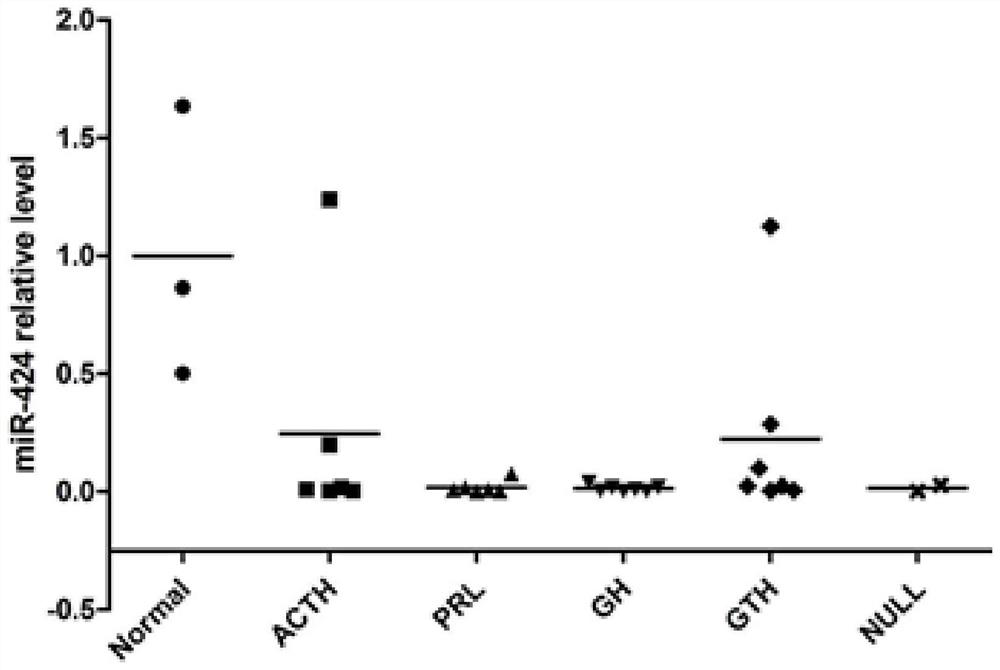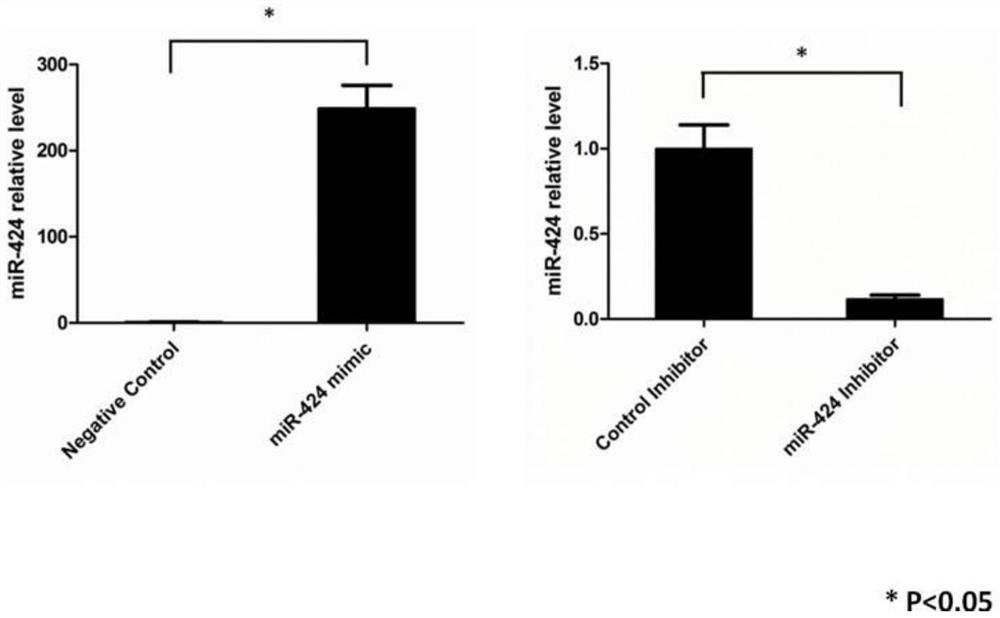Application of miRNA-424 as diagnostic marker of pituitary adenoma
A technology of miRNA-424 and diagnostic markers, which is applied in the field of biomedicine and can solve problems such as deficiency
- Summary
- Abstract
- Description
- Claims
- Application Information
AI Technical Summary
Problems solved by technology
Method used
Image
Examples
Embodiment 1
[0046] Example 1 qPCR verification of differentially expressed miRNA-424
[0047] 1. Sample acquisition
[0048] 5 cases of normal pituitary gland tissues and 53 cases of pituitary tumor tissues including all 5 subtypes were collected. All the above specimens were obtained with the consent of the organizational ethics committee.
[0049] 2. Extraction of total RNA from samples
[0050] Total RNA in advance using QIAGEN Tissue RNA Extraction Kit.
[0051] Specific steps are as follows:
[0052] 1) In a clean area with less RNase interference, use a mortar containing an appropriate amount of liquid nitrogen to weigh about 20 mg of the tissue sample, and grind it to powder with a pestle;
[0053] 2) Transfer the sample to a RNase-free 2mL centrifuge tube;
[0054] 3) Add 300 μL Lysis solution, place in a homogenizer, and grind thoroughly for 1-5 minutes;
[0055] 4) 12000g, 4°C, centrifuge for 10min, transfer the supernatant to a new 1.5mL centrifuge tube;
[0056] 5) Add ...
Embodiment 2
[0087] Example 2 Identification of miRNAs specifically expressed in pituitary tumors and their key target genes
[0088] 1. Bioinformatics method to predict the potential key target genes of miRNA-424
[0089]Combine multiple methods to improve the accuracy of analysis, use TargetScan, miRecords and PicTar and other software for prediction, and take the intersection of several prediction software results for analysis. Because this bioinformatics analysis may obtain a large number of possible target genes, it is necessary to focus on selecting potential target genes that may function in the occurrence and development of pituitary tumors for analysis on the basis of existing pituitary tumor research. For one miRNA, multiple possible target genes can be analyzed and verified simultaneously to increase the success rate.
[0090] 2. Results
[0091] The possible key target genes of miR-424 were predicted by bioinformatics analysis. The results showed that the 3' non-coding regio...
Embodiment 3
[0092] Example 3 Detection of expression of miRNA-424 and HMGA1 in pituitary tumor cells by qPCR and detection of HMGA1 protein expression by western blotting
[0093] 1. Cell culture
[0094] GT1-1 cells were routinely cultured in F-12 medium containing 5% fetal bovine serum and 5% horse serum at 37°C, 5% CO 2 and cultured under saturated humidity conditions.
[0095] 2. Cell transfection
[0096] The GT1-1 cells were divided into four groups, the experimental group was transfected with miRNA-424 mimics and miRNA-424 inhibitors, the negative control group was transfected with random control sequences, and the liposome control group was transfected with LipofectamineTM 3000 lipid In vivo transfection reagent group, and the blank control group was the non-transfection group. The transfection reagent LipofectamineTM 3000 was used for transfection, and the transfection method was referred to the instructions. The working concentration of both the control group and the experim...
PUM
 Login to View More
Login to View More Abstract
Description
Claims
Application Information
 Login to View More
Login to View More - R&D
- Intellectual Property
- Life Sciences
- Materials
- Tech Scout
- Unparalleled Data Quality
- Higher Quality Content
- 60% Fewer Hallucinations
Browse by: Latest US Patents, China's latest patents, Technical Efficacy Thesaurus, Application Domain, Technology Topic, Popular Technical Reports.
© 2025 PatSnap. All rights reserved.Legal|Privacy policy|Modern Slavery Act Transparency Statement|Sitemap|About US| Contact US: help@patsnap.com



